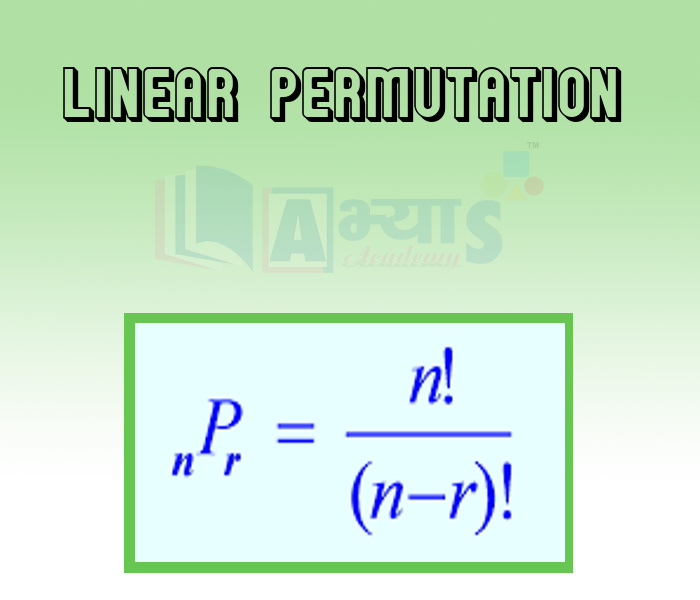Linear Permutation






Linear Permutation
Permutation
All the possible ways the things can be arranged by using some or all the things are called permutation. Thus each of the arrangements which can be made by taking some or all number of things is called a permutation.
The various ways in which the three things can be arranged by taking two at a time are known as the permutation of three things takes two at a time.
The permutations which can be made by taking the letters a, b and c by taking two at a time are 6 i.e., ab, bc, ac, ba, cb and ca. Each of these presenting a different arrangement of two letters. These six arrangements are called permutations of three things takes two at a time.
Types of Permutation
Permutation is generally of two types
1. Linear permutation
2. Circular permutation
1. Linear Permutation
If the things are arranged in a row/line, then a permutation is called linear permutation. It is simply written as a permutation.
Number of permutations of n dissimilar things taken r at a time is
Where, n! is the product of the first n natural numbers and called n - factorial or factorial n denoted by n!.
e.g., 5! = 5 X 4 X 3 X 3 X 2 X 1 = 120
When n is a negative integer or a fraction, where n! is not defined. Thus, n! is defined only for positive integers.
According to the above definition, 0! makes no sense.
However, we define 0! = 1
For example, The total ways in which the letters of word 'DISCOVER' can be arranged in which all vowels are always together is
Here the total letters are = 8
No of vowels = 3
So in the formula m= 3 and n =8
(because there are 3 vowels)
In how many ways can 6 persons stand in a queue? | |||
| Right Option : A | |||
| View Explanation | |||
If P(n , 4) = 20 X P(n , 2) , Find n. | |||
| Right Option : B | |||
| View Explanation | |||
If 10Pr = 5040 , find the value of r. | |||
| Right Option : A | |||
| View Explanation | |||
Students / Parents Reviews [10]
Abhyas is a complete education Institute. Here extreme care is taken by teacher with the help of regular exam. Extra classes also conducted by the institute, if the student is weak.

Om Umang
10thBeing a parent, I saw my daughter improvement in her studies by seeing a good result in all day to day compititive exam TMO, NSO, IEO etc and as well as studies. I have got a fruitful result from my daughter.

Prisha Gupta
8thAbout Abhyas metholodology the teachers are very nice and hardworking toward students.The Centre Head Mrs Anu Sethi is also a brilliant teacher.Abhyas has taught me how to overcome problems and has always taken my doubts and suppoeted me.

Shreya Shrivastava
8thOne of the best institutes to develope a child interest in studies.Provides SST and English knowledge also unlike other institutes. Teachers are co operative and friendly online tests andPPT develope practical knowledge also.

Aman Kumar Shrivastava
10thIt was a good experience with Abhyas Academy. I even faced problems in starting but slowly and steadily overcomed. Especially reasoning classes helped me a lot.

Cheshta
10thI have spent a wonderful time in Abhyas academy. It has made my reasoning more apt, English more stronger and Maths an interesting subject for me. It has given me a habbit of self studying

Yatharthi Sharma
10thIt has a great methodology. Students here can get analysis to their test quickly.We can learn easily through PPTs and the testing methods are good. We know that where we have to practice

Barkha Arora
10thMy experience with Abhyas is very good. I have learnt many things here like vedic maths and reasoning also. Teachers here first take our doubts and then there are assignments to verify our weak points.

Shivam Rana
7thMy experience with Abhyas academy is very good. I did not think that my every subject coming here will be so strong. The main thing is that the online tests had made me learn here more things.

Hiya Gupta
8thMy experience was very good with Abhyas academy. I am studying here from 6th class and I am satisfied by its results in my life. I improved a lot here ahead of school syllabus.
